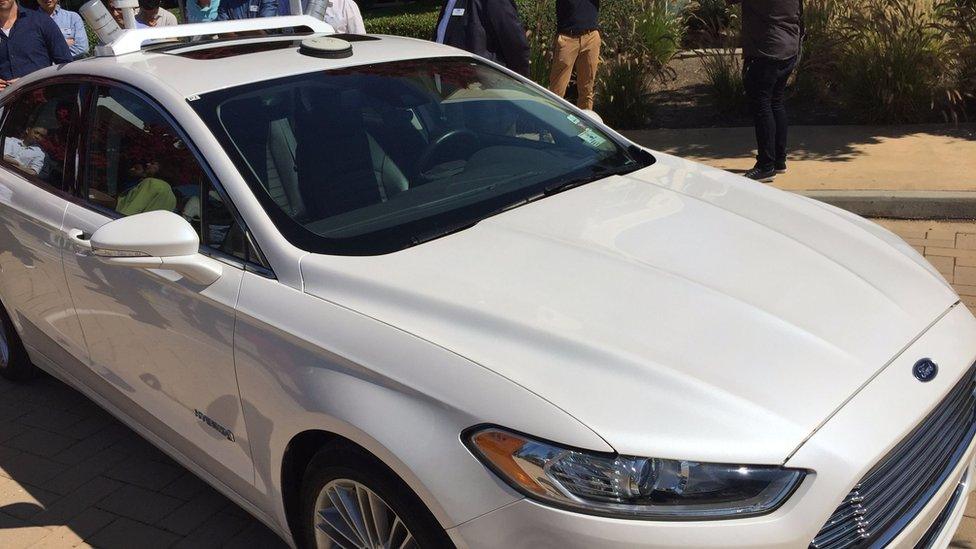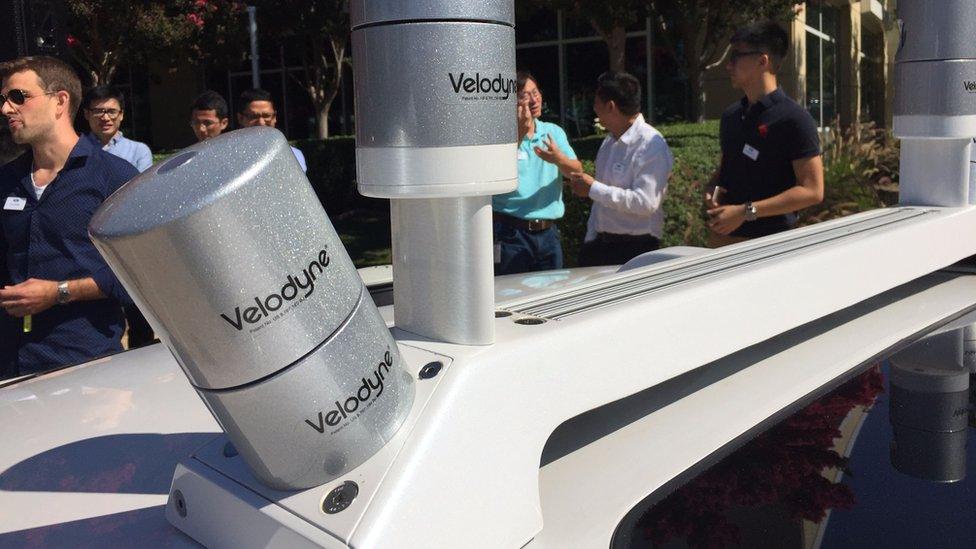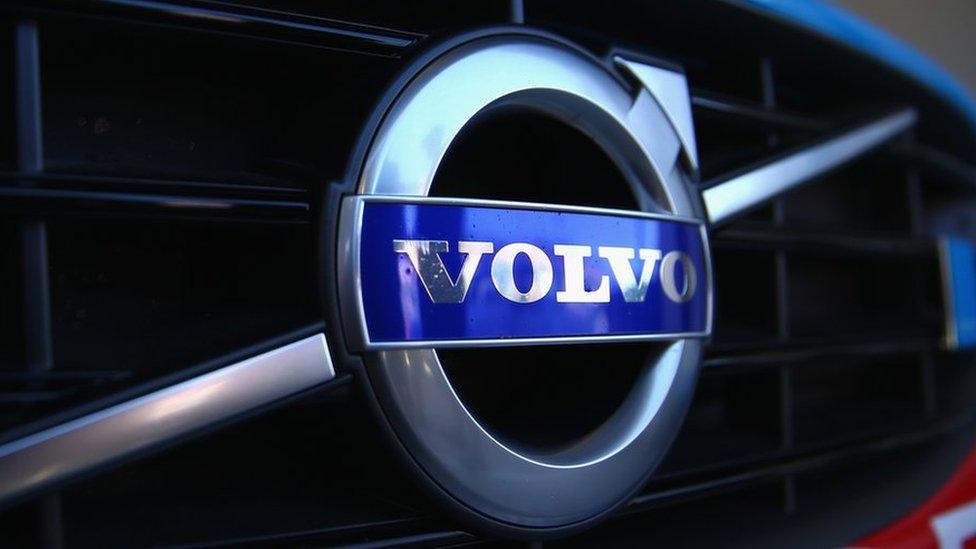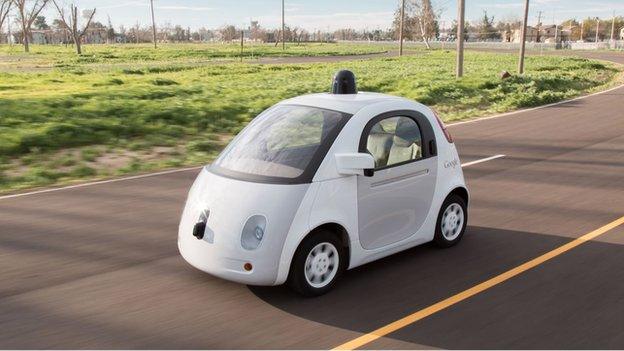Ford's self-driving car 'coming in 2021'
- Published
- comments
Ford's president Mark Fields explained the driverless car plan to BBC's Dave Lee
Ford has said it will mass-produce a fully autonomous self-driving car without a steering wheel by 2021.
The bold ambition was outlined by the company’s president, Mark Fields, at an event in Palo Alto, California.
Ford said it would double its investment in its research centre in the city, as well as making sizable investments in technology companies in the autonomy industry.
The firm said the car would be in use by customers by 2021.
It said this was most likely as part of an Uber-like ride-sharing service - but one that doesn’t require a human driver.

Eventually, Ford's mass-produced self-driving car will not have a steering wheel
“As you can imagine, the experience inside a vehicle where you don’t have to take control changes everything,” said Mr Fields, in an interview with the BBC.
“Whether you want to do work, whether you want entertainment… those are the types of things we are thinking about as we design the experience for this type of autonomous vehicle."
The announcement, described as “transformational” by Mr Fields, signalled an era when Ford sees itself, particularly in cities, as a company that provides an ad-hoc service rather than focusing solely on selling the cars to the general public.
“There will be a growing per cent of the industry that will be fully autonomous vehicles,” Mr Fields said.
"Our goal is not only to be an auto company, but an auto and mobility company.”
Level up
In recent years Ford has described itself as a technology company rather than simply a car maker, and on Tuesday it genuinely started to sound like one.

Ford has invested in Velodyne, a company that works on LiDAR technology
In partnership with Chinese firm Baidu, Ford has made a joint investment of $150m (£115m) in Velodyne - a company that works on light detection and ranging (LiDAR) technology. LiDAR is the system used for accurately detecting objects around the car.
Ford was also part of an investment round that raised $6.6m for Civil Maps - a digital mapping company - as well as money put towards neuroscience research.
Tellingly, there was no mention of Google or Apple in Ford’s announcement - a suggestion it has opted to compete against the Silicon Valley giants rather than try and work with them as some had originally anticipated.
But Google still leads the way in self-driving technology - its cars have been out on public roads clocking up miles for several years now. It too is developing a car without a steering wheel - but regulations so far prevent that car from venturing beyond private land.
Like Google, Ford said it would be focusing on “Level 4” autonomy in reference to the standards put in place by the US-based Society of Automotive Engineers (SAE).
The levels represent the sophistication of self-driving technology. At Level four - “high automation” - the car is able to operate, unmonitored, in a particular use case. For Ford, the use case would be a city area. Level 5 would mean full autonomy in any driving condition.
The company said it was not interested in offering Level three driving. Level two means some level of automation that requires the driver to monitor the car at all times.
Isolated Tesla
Tesla’s Autopilot, which changes lanes and monitors traffic flow, is officially Level two - although critics say human nature means drivers are instinctively treating Autopilot as if it were in fact Level three automation. Level three is when constant monitoring is not required, but drivers should be ready to take control in emergencies. Tesla’s technology is under investigation by US road safety regulators after it was blamed for causing the death of a driver earlier this year.
Tesla chief executive Elon Musk defended the roll-out of Autopilot in a recent blog post:
"When used correctly, it is already significantly safer than a person driving by themselves and it would therefore be morally reprehensible to delay release simply for fear of bad press or some mercantile calculation of legal liability," he wrote.
At its announcement, Ford chief technical officer Raj Nair said the company wasn’t satisfied that drivers could safely take control from a level two or three vehicle at a moment’s notice.
“We don’t yet know how to manage hand over back to the driver and have him engage and have him situationally aware, and be able to do that in a safe aware manner,” he said.
This approach chimes with the views of Google which in the past has expressed concern about the safety implications of semi-autonomous driving. It leaves Tesla, with Autopilot, isolated among auto makers.
"Tesla is unique in that it’s allowing its users to be beta testers,” said Wayne Cunningham, managing editor of motoring news website Road Show, external.
"No other company thinks that way."
On Ford’s 2021 pledge, Mr Cunningham told the BBC it was a feasible goal but one that was intentionally narrow.
"It’s not as an aggressive step as it sounds,” he said.
"This is really a car designed for very specific urban environments. It’s a car that’s going to take people at 20-30 mph through city centres."
Follow Dave Lee on Twitter @DaveLeeBBC, external and on Facebook, external
- Published29 February 2016
- Published27 April 2016

- Published15 March 2016
